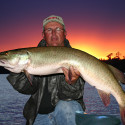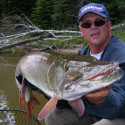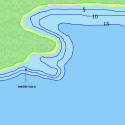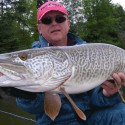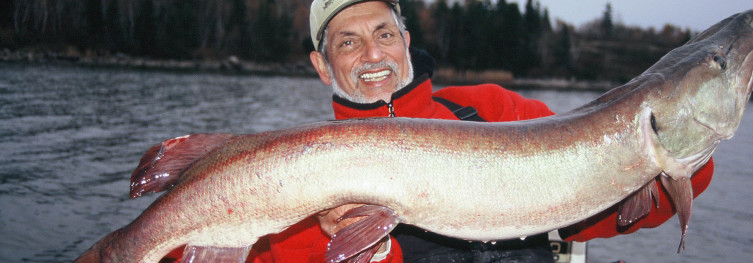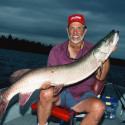By Joe Bucher
September is arguably the best all around month of the year for the outdoorsman. The old adage “so much do to, and so little time” sure applies to this month. Personally, I am pulled in so many different directions in September and it’s all good. By 5 a.m. I’m loading my gear in my ATV and getting ready to bow hunt the first three hours of daylight. By mid day, I’m on the water jigging for walleyes or casting for muskies. If the weather is mild, I might even grab the shotgun and walk a logging road for grouse. Depending upon my mood on any given September day, my evenings are spent either back in a treestand or casting a TopRaider over a promising weed bed for muskies once again. What a month!
Yet, this article is all about that one September passion – muskies. So I won’t waste anymore time talking about the other things we all do during this wonderful month even though they are all great fall hobbies. Chasing big muskies is one of the ultimate things to do during “the month of change”. September, of course, marks the end of summer and the beginning of fall. It’s truly a month of change. Stark recognizable changes occur throughout the month of September in weather patterns, water temperature, and plant growth as well as the behavior of both fish and game. Muskies are no different in this regard. Their location and their demeanor changes as September arrives – both for the positive. Here’s the skinny on what I consider to be one of the best opportunities to bag a big one in our local Wisconsin waters.
September simplifies musky location and makes it far more predictable. The subtle change in photoperiod, with gradually shortening days and longer nights begins to cool a lake’s water temperatures as well as trigger muskies to move away from deeper open waters into shallower locations. Oddly enough, deeper water becomes a less stable environment as water temps begin to drop and the annual fall turnover of a lake begins. All fish, including muskies sense this change from both the change in daylight, photoperiodism, as well as the drop in water temperature. They (muskies) instinctively want to get away from this less stable environment, and begin to migrate inward. This puts them within reach of classic musky casting presentations, and that’s what I want to tip you off too.
The best looking shallow areas, often classic looking musky spots, such as thick weedbeds and shallow rock reefs are now top choices. These same spots might have had an average sized fish (muskie) in them a few weeks back, but now they could contain the biggest fish in the lake. In fact, it is almost a sure bet a big trophy class fish will be in the shallows at this time. I’m not guaranteeing that they will always be active or come roaring out to grab your lure, but the odds are very high that your casts will be in range of a trophy a high percentage of the time.
Concentrate your efforts now on the best looking shallow water areas. In Wisconsin, where most of our waters are under 3,000 acres in size, you could probably narrow down your search to less than ten total spots. In some of our smaller muskie waters, there might be only 3 to 4 prime shallow water muskie haunts total. In other words, location is fairly simple and easy to recognize. Spend all of your time fishing the best 3 to 10 shallow water spots on these lakes and you will be casting over a big fish 90% of the time.
My absolute favorite Wisconsin trophy musky habitat in September is a thick bed of milfoil or coontail weeds. For some reason, this specific weed species attracts huge concentrations of baitfish at this time and muskies consequently hang around them too. The thicker the weed clump, the more potential it has. The bigger the clump, the more it is apt to hold multiple muskies. On top of that, once you find a good “coontail clump” it is apt to produce time and time again.
The best lures for this technique are obvious. Any high riding shallow bait is apt to trigger a reaction. My three favorites are the traditional straight shaft in-line bucktail spinner, a large musky sized single hook spinnerbait, and finally a topwater bait. However, a buoyant jerkbait or minnow bait worked in an up/down jerkbait fashion might also be a great choice in bright bluebird cold front days when muskies are less apt to leave the weeds to chase down a bait.
Dark overcast days with a drizzle are sure to have the best potential overall. The drop in light encourages these big fish to rise up out of the weedy canopy and hover near the weed tops just under the actual water surface. That is why is important to make long casts the reach beyond the where you expect the fish to be hanging so they are not spooked by a surprised loud bait entry. If you are using a sinking bait, such as bucktail or spinnerbait, make certain to engage your reel instantly and crank hard initially to keep the bait up near the top. In fact, bulging a spinner mere inches below the surface can be super deadly now.
Sometimes the best weeds are so close to the surface that they are difficult to fish with any subsurface bait; especially one with a big treble hook. This is where topwater baits come into play. Few muskie anglers consider casting topwater lures after Labor Day, but I can assure you this is a mistake. Topwater baits attract and catch big muskies well into early October when this shallow “coontail clump” pattern is in play. Simply put, if the fish are there – in the shallow weeds – topwater is apt to catch ‘em.
That’s the pattern in a nutshell. Location is simple and so is lure selection and presentation. Don’t miss out on this rare opportunity to encounter the biggest muskies in our local lakes, rivers and flowages shallow. They are sitting up in those thick “coontail clumps” just waiting for a lure to pass over them!
